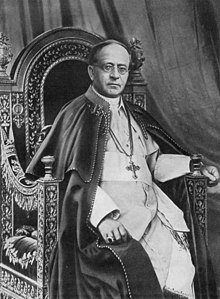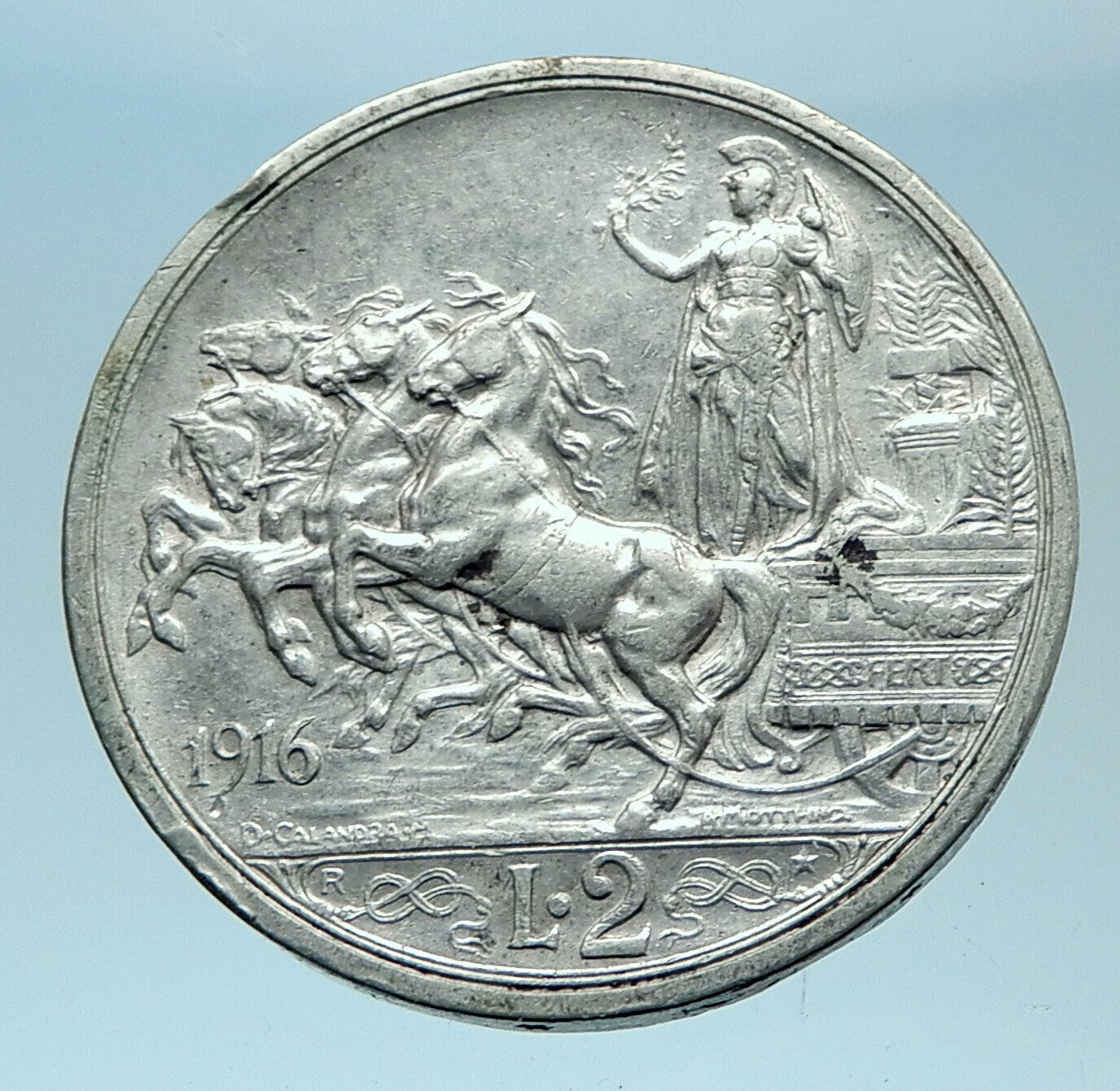|
Vatican City
Jubilee
Pius XI: Pope – 6 February 1922 – 10 February 1939
1933 Nickel
20 Centesimi 21mm (4.10 grams)
Reference: KM# 13, Schön# 12 | Engraver: Aurelio Mistruzzi
PIVS·XI·PONT MAX·AN·IVB· 1933 1934, Crowned Coat-of-arms divides date.
STATO DELLA CITTÀ DEL VATICANO C. 20, Bust of St. Paul left.
You are bidding on the exact item pictured, provided with a Certificate of Authenticity and Lifetime Guarantee of Authenticity.
Click here to see all Christian Medals and Objects for Sale
 Pope Pius XI (Italian: Pio XI), born Ambrogio Damiano Achille Ratti (31 May 1857 – 10 February 1939), was head of the Catholic Church from 6 February 1922 to his death in 1939. He was the first sovereign of Vatican City from its creation as an independent state on 11 February 1929. He took as his papal motto, “Pax Christi in Regno Christi,” translated “The Peace of Christ in the Kingdom of Christ.” Pope Pius XI (Italian: Pio XI), born Ambrogio Damiano Achille Ratti (31 May 1857 – 10 February 1939), was head of the Catholic Church from 6 February 1922 to his death in 1939. He was the first sovereign of Vatican City from its creation as an independent state on 11 February 1929. He took as his papal motto, “Pax Christi in Regno Christi,” translated “The Peace of Christ in the Kingdom of Christ.”
Pius XI issued numerous encyclicals, including Quadragesimo anno on the 40th anniversary of Pope Leo XIII’s groundbreaking social encyclical Rerum novarum, highlighting the capitalistic greed of international finance, the dangers of socialism/communism, and social justice issues, and Quas primas, establishing the feast of Christ the King in response to anti-clericalism. The encyclical Studiorum ducem, promulgated 29 June 1923, was written on the occasion of the 6th centenary of the canonization of Thomas Aquinas, whose thought is acclaimed as central to Catholic philosophy and theology. The encyclical also singles out the Pontifical University of Saint Thomas Aquinas, Angelicum as the preeminent institution for the teaching of Aquinas: “ante omnia Pontificium Collegium Angelicum, ubi Thomam tamquam domi suae habitare dixeris” (before all others the Pontifical Angelicum College, where Thomas can be said to dwell).To establish or maintain the position of the Catholic Church, Pius XI concluded a record number of concordats, including the Reichskonkordat with Nazi Germany, whose betrayals of which he condemned four years later in the encyclical Mit brennender Sorge (“With Burning Concern”). During his pontificate, the longstanding hostility with the Italian government over the status of the papacy and the Church in Italy was successfully resolved in the Lateran Treaty of 1929. He was unable to stop the persecution of the Church and the killing of clergy in Mexico, Spain and the Soviet Union. He canonized important saints, including Thomas More, Peter Canisius, Bernadette of Lourdes and Don Bosco. He beatified and canonized Thérèse de Lisieux, for whom he held special reverence, and gave equivalent canonization to Albertus Magnus, naming him a Doctor of the Church due to the spiritual power of his writings. He took a strong interest in fostering the participation of lay people throughout the Catholic Church, especially in the Catholic Action movement. The end of his pontificate was dominated by speaking out against Hitler and Mussolini and defending the Catholic Church from intrusions into Catholic life and education.
Pius XI died on 10 February 1939 in the Apostolic Palace and is buried in the Papal Grotto of Saint Peter’s Basilica. In the course of excavating space for his tomb, two levels of burial grounds were uncovered which revealed bones now venerated as the bones of St. Peter.
 Vatican City, officially Vatican City State (Italian: Stato della Città del Vaticano; Latin: Status Civitatis Vaticanae), is an independent city-state enclaved within Rome, Italy. Established with the Lateran Treaty (1929), it is distinct from, yet under “full ownership, exclusive dominion, and sovereign authority and jurisdiction” of the Holy See (Latin: Sancta Sedes). With an area of 44 hectares (110 acres), and a population of about 1,000,[3] it is the smallest sovereign state in the world by both area and population. Vatican City, officially Vatican City State (Italian: Stato della Città del Vaticano; Latin: Status Civitatis Vaticanae), is an independent city-state enclaved within Rome, Italy. Established with the Lateran Treaty (1929), it is distinct from, yet under “full ownership, exclusive dominion, and sovereign authority and jurisdiction” of the Holy See (Latin: Sancta Sedes). With an area of 44 hectares (110 acres), and a population of about 1,000,[3] it is the smallest sovereign state in the world by both area and population.
The Vatican City is an ecclesiastical or sacerdotal-monarchical state (a type of theocracy) ruled by the pope who is the bishop of Rome and head of the Catholic Church. The highest state functionaries are all Catholic clergy of various national origins. Since the return of the popes from Avignon in 1377, they have generally resided at the Apostolic Palace within what is now Vatican City, although at times residing instead in the Quirinal Palace in Rome or elsewhere.
The Holy See dates back to early Christianity, and is the primate episcopal see of the Catholic Church, with 1.3 billion Catholic Christians around the world distributed in the Latin Church and 23 Eastern Catholic Churches. The independent Vatican City-state, on the other hand, came into existence on 11 February 1929 by the Lateran Treaty between the Holy See and Italy, which spoke of it as a new creation, not as a vestige of the much larger Papal States (756-1870), which had previously encompassed much of central Italy.
Within the Vatican City are religious and cultural sites such as St. Peter’s Basilica, the Sistine Chapel, and the Vatican Museums. They feature some of the world’s most famous paintings and sculptures. The unique economy of Vatican City is supported financially by the sale of postage stamps and souvenirs, fees for admission to museums, and sales of publications.
|





 Pope Pius XI (Italian: Pio XI), born Ambrogio Damiano Achille Ratti (31 May 1857 – 10 February 1939), was head of the Catholic Church from 6 February 1922 to his death in 1939. He was the first sovereign of Vatican City from its creation as an independent state on 11 February 1929. He took as his papal motto, “Pax Christi in Regno Christi,” translated “The Peace of Christ in the Kingdom of Christ.”
Pope Pius XI (Italian: Pio XI), born Ambrogio Damiano Achille Ratti (31 May 1857 – 10 February 1939), was head of the Catholic Church from 6 February 1922 to his death in 1939. He was the first sovereign of Vatican City from its creation as an independent state on 11 February 1929. He took as his papal motto, “Pax Christi in Regno Christi,” translated “The Peace of Christ in the Kingdom of Christ.”  Vatican City, officially Vatican City State (Italian: Stato della Città del Vaticano; Latin: Status Civitatis Vaticanae), is an independent city-state enclaved within Rome, Italy. Established with the Lateran Treaty (1929), it is distinct from, yet under “full ownership, exclusive dominion, and sovereign authority and jurisdiction” of the Holy See (Latin: Sancta Sedes). With an area of 44 hectares (110 acres), and a population of about 1,000,[3] it is the smallest sovereign state in the world by both area and population.
Vatican City, officially Vatican City State (Italian: Stato della Città del Vaticano; Latin: Status Civitatis Vaticanae), is an independent city-state enclaved within Rome, Italy. Established with the Lateran Treaty (1929), it is distinct from, yet under “full ownership, exclusive dominion, and sovereign authority and jurisdiction” of the Holy See (Latin: Sancta Sedes). With an area of 44 hectares (110 acres), and a population of about 1,000,[3] it is the smallest sovereign state in the world by both area and population. 




